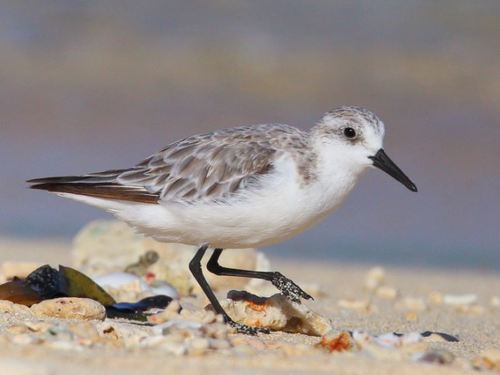
Sanderling
The Sanderling (Calidris alba) is a small, highly active shorebird known for its characteristic 'wave-chasing' behavior along sandy beaches worldwide. It plays a crucial role in coastal ecosystems as both predator and prey, consuming invertebrates and serving as a food source for larger birds and mammals. Its remarkable long-distance migrations, connecting breeding grounds in the high Arctic with wintering sites across six continents, make it a symbol of global interconnectedness. While not currently considered globally threatened, the Sanderling faces increasing pressures from habitat loss and climate change.
18-20 cm
Length
35-39 cm
Wingspan
Least Concern
Conservation Status
Distribution
Sanderlings have a nearly global distribution. They breed in the high Arctic regions of North America, Europe, and Asia. During the non-breeding season, they migrate south to coastal areas across North and South America, Europe, Africa, Asia, Australia, and many Pacific Islands. Their migratory routes can span thousands of kilometers.
Lifespan
The average lifespan in the wild is around 6-7 years, but some individuals have been recorded to live over 13 years.
Sanderling's Habitat
Habitat Types
Sandy beaches, Tidal mudflats, Coastal lagoons, Salt marshes (less frequently)
Climate Zones
Arctic (breeding), Temperate, Tropical, Subtropical
Adaptations
Sanderlings are well-adapted to coastal environments. Their relatively long legs and bill allow them to probe for prey in sand and mud. Their countershaded plumage (dark above, light below) provides camouflage in their open habitats. They can tolerate a wide range of temperatures, from freezing Arctic conditions to hot tropical beaches.
Variations
Two subspecies are generally recognized: *Calidris alba alba* (breeds in Greenland, northern Europe, and western Siberia) and *Calidris alba rubida* (breeds in northeastern Siberia and North America). There are subtle differences in plumage and size between these subspecies.
Appearance
Breeding Plumage
Breeding plumage is characterized by a rusty-red head, breast, and upperparts with dark streaks. Non-breeding plumage is much paler, with a light gray back and white underparts.
Seasonal Feather Changes
The transition between breeding and non-breeding plumage occurs through molting, typically starting in late summer after breeding and completing before the southward migration. A pre-breeding molt occurs before the northward migration.
Sex Based Plumage Differences
Males and females have similar plumage, although males may be slightly brighter in breeding plumage.
Notable Features
Black legs and bill, White wing stripe visible in flight, Distinctive 'wave-chasing' foraging behavior
Diet and Feeding
Primary Foods
Small crustaceans (e.g., amphipods, crabs), Mollusks, Insects, Polychaete worms, Horseshoe crab eggs (seasonally important)
Foraging Behavior
Sanderlings are known for their energetic foraging style, running along the edge of receding waves and probing the wet sand for prey. They use both visual and tactile cues to locate food.
Specializations
Their bill is well-suited for probing in sand and mud. They have a good sense of touch at the bill tip, allowing them to detect buried prey.
Seasonal Diet Variations
During the breeding season in the Arctic, their diet consists mainly of insects and other terrestrial invertebrates. On their wintering grounds, they primarily consume marine invertebrates.
Behavior
Social Structure
Sanderlings are highly gregarious outside of the breeding season, often forming large flocks on their wintering grounds and during migration. During the breeding season, they are territorial.
Communication
A sharp 'wick-wick' flight call, A soft 'twick' contact call, Various chattering and trilling sounds during courtship and territorial defense
Migration
Sanderlings are long-distance migrants, with some populations traveling over 10,000 kilometers between their breeding and wintering grounds. They often fly in large flocks and make stopovers at key staging areas to refuel.
Territorial or Group Behaviors
During the breeding season, males defend territories around the nest site. On the wintering grounds, they may defend small feeding territories, but often forage in close proximity to other individuals.
Conservation
Threats
Habitat loss and degradation (coastal development, erosion), Climate change (sea-level rise, changes in prey availability), Disturbance from human activities (recreation, dogs), Pollution (oil spills, plastic debris), Over-harvesting of horseshoe crabs (reducing a key food source)
Protection Programs
International Migratory Bird Treaty Act, Western Hemisphere Shorebird Reserve Network (WHSRN), Various national and local conservation initiatives focused on coastal habitat protection
Local National Laws
Protected under various national wildlife laws in many countries.
Population Trend
Stable overall, but some populations are declining.
Population Estimates
The global population is estimated to be around 700,000 individuals.
Interesting Facts
Sanderlings are one of the most widespread shorebirds in the world.
They can be found on coastlines across six continents.
They are famous for their 'wave-chasing' behavior.
This allows them to efficiently capture small invertebrates exposed by receding waves.
Sanderlings undertake some of the longest migrations of any shorebird.
Some individuals travel over 10,000 km between their breeding and wintering grounds.
They are almost exclusively found along sandy coastlines.
Their name *'Sanderling'* directly translates to *'sand-dweller'*.
Faqs about Sanderling
What do Sanderlings eat?
Sanderlings eat a variety of small invertebrates, including crustaceans, mollusks, insects, and worms. They find their food by probing in the sand and mud along the shoreline.
Where do Sanderlings breed?
Sanderlings breed in the high Arctic tundra regions of North America, Europe, and Asia.
How long do Sanderlings live?
The average lifespan of a Sanderling in the wild is about 6-7 years, but some individuals can live much longer.
Are Sanderlings endangered?
Sanderlings are currently classified as 'Least Concern' by the IUCN, but some populations are facing threats from habitat loss and climate change.
Copyright @ Nature Style Limited. All Rights Reserved.
 English
English